GO-Based Membranes for Desalination
Abstract
1. Introduction
2. Preparation Methods of GO Membranes
2.1. Pressure-Assisted Self-Assembly (PAS)
2.2. Layer-by-Layer Assembly (LBLA)
2.3. Spray and Spin Coating
2.4. Dehydration
3. Transport Mechanism of Small Molecules in GOMs
4. Regulation of GOM Mass Transfer Pathways
4.1. Regulation of Interlayer Spacing
4.1.1. Reduction of Graphene Oxide
4.1.2. Cation Intercalation
4.1.3. Covalent Cross-Linking
4.1.4. Polymer Intercalation
4.1.5. Inorganic Particle Intercalation
4.2. Regulation of Longitudinal Mass Transfer Channels
4.2.1. Decorating the Longitudinal Mass Transfer Channel of the GO Nanosheets
4.2.2. Construction of Fast Longitudinal Mass Transfer Channels
4.3. Regulation of GO Surface Wrinkles
5. Conclusions and Perspectives
Author Contributions
Funding
Institutional Review Board Statement
Conflicts of Interest
References
- Kandjou, V.; Perez-Mas, A.M.; Acevedo, B.; Hernaez, M.; Mayes, A.G.; Melendi-Espina, S. Enhanced covalent p-phenylenediamine crosslinked graphene oxide membranes: Towards superior contaminant removal from wastewaters and improved membrane reusability. J. Hazard. Mater. 2019, 380, 120840. [Google Scholar] [CrossRef] [PubMed]
- Liang, B.; Zhan, W.; Qi, G.; Lin, S.; Nan, Q.; Liu, Y.; Cao, B.; Pan, K. High performance graphene oxide/polyacrylonitrile composite pervaporation membranes for desalination applications. J. Mater. Chem. A 2015, 3, 5140–5147. [Google Scholar] [CrossRef]
- Zahid, M.; Khalid, T.; Rehan, Z.A.; Javed, T.; Akram, S.; Rashid, A.; Mustafa, S.K.; Shabbir, R.; Mora-Poblete, F.; Asad, M.S.; et al. Fabrication and Characterization of Sulfonated Graphene Oxide (SGO) Doped PVDF Nanocomposite Membranes with Improved Anti-Biofouling Performance. Membranes 2021, 11, 749. [Google Scholar] [CrossRef]
- Ayaz, M.; Namazi, M.A.; Din, M.A.u.; Ershath, M.I.M.; Mansour, A.; Aggoune, E.-H.M. Sustainable seawater desalination: Current status, environmental implications and future expectations. Desalination 2022, 540, 116022. [Google Scholar] [CrossRef]
- Alkhouzaam, A.; Qiblawey, H. Functional GO-based membranes for water treatment and desalination: Fabrication methods, performance and advantages. A review. Chemosphere 2021, 274, 129853. [Google Scholar] [CrossRef]
- Chen, B.; Jiang, H.F.; Liu, X.; Hu, X.J. Observation and Analysis of Water Transport through Graphene Oxide Interlamination. J. Phys. Chem. C 2017, 121, 1321–1328. [Google Scholar] [CrossRef]
- Chen, X.; Liu, G.P.; Zhang, H.; Fan, Y.Q. Fabrication of graphene oxide composite membranes and their application for pervaporation dehydration of butanol. Chin. J. Chem. Eng. 2015, 23, 1102–1109. [Google Scholar] [CrossRef]
- Hafiz, M.A.; Hawari, A.H.; Altaee, A. A hybrid forward osmosis/reverse osmosis process for the supply of fertilizing solution from treated wastewater. J. Water Process Eng. 2019, 32, 100975. [Google Scholar] [CrossRef]
- Speed, D.E. Environmental aspects of planarization processes. In Advances in Chemical Mechanical Planarization (CMP), 2nd ed.; Babu, S., Ed.; Woodhead Publishing: Berlin, Germany, 2016; pp. 229–269. [Google Scholar]
- Ganora, D.; Dorati, C.; Huld, T.A.; Udias, A.; Pistocchi, A. An assessment of energy storage options for large-scale PV-RO desalination in the extended Mediterranean region. Sci. Rep. 2019, 9, 16234. [Google Scholar] [CrossRef]
- Liang, C.Z.; Askari, M.; Choong, L.T.S.; Chung, T.S. Ultra-strong polymeric hollow fiber membranes for saline dewatering and desalination. Nat. Commun. 2021, 12, 2338. [Google Scholar] [CrossRef]
- Saeed, R.; Konsowa, A.H.; Shalaby, M.S.; Mansour, M.S.; Eloffy, M.G. Optimization of Integrated Forward—Reverse Osmosis Desalination Processes for Brackish Water. Alex. Eng. J. 2023, 63, 89–102. [Google Scholar] [CrossRef]
- Gui, L.; Cui, Y.; Zhu, Y.; An, X.; Lan, H.; Jin, J. g-C3N4 nanofibers network reinforced polyamide nanofiltration membrane for fast desalination. Sep. Purif. Technol. 2022, 293, 121125. [Google Scholar] [CrossRef]
- Febriasari, A.; Huriya; Ananto, A.H.; Suhartini, M.; Kartohardjono, S. Polysulfone-Polyvinyl Pyrrolidone Blend Polymer Composite Membranes for Batik Industrial Wastewater Treatment. Membranes 2021, 11, 66. [Google Scholar] [CrossRef] [PubMed]
- Zhan, X.; Gao, Z.; Ge, R.; Lu, J.; Li, J.; Wan, X. Rigid POSS intercalated graphene oxide membranes with hydrophilic/hydrophobic heterostructure for efficient pervaporation desalination. Desalination 2022, 543, 116106. [Google Scholar] [CrossRef]
- Nigiz, F.U. Graphene oxide-sodium alginate membrane for seawater desalination through pervaporation. Desalination 2020, 485, 114465. [Google Scholar] [CrossRef]
- Bell, C.-M. Comparison of polyelectrolyte coated PVDF membranes in thermopervaporation with porous hydrophobic membranes in membrane distillation using plate-and-frame modules. Chem. Eng. Process. 2016, 104, 58–65. [Google Scholar] [CrossRef]
- Xu, S.; Zhou, H.; Jia, H.; Xu, J.; Ma, L.; Zang, Y.; Jiang, P.; Ma, W.; Zhang, Y.; Zhao, W.; et al. Preparation and High Performance of Cellulose Acetate Films by Grafting with Imidazole Ionic Liquid. ACS Omega 2021, 6, 12500–12506. [Google Scholar] [CrossRef] [PubMed]
- Wang, Z.; Sun, J.; Li, N.; Qin, Y.; Qian, X.; Xie, Z. Tuning interlayer structure to construct steady dual-crosslinked graphene oxide membranes for desalination of hypersaline brine via pervaporation. Sep. Purif. Technol. 2022, 286, 120459. [Google Scholar] [CrossRef]
- Abraham, J.; Vasu, K.S.; Williams, C.D.; Gopinadhan, K.; Su, Y.; Cherian, C.T.; Dix, J.; Prestat, E.; Haigh, S.J.; Grigorieva, I.V.; et al. Tunable sieving of ions using graphene oxide membranes. Nat. Nanotechnol. 2017, 12, 546–550. [Google Scholar] [CrossRef]
- Lim, M.-Y.; Choi, Y.-S.; Shin, H.; Kim, K.; Shin, D.M.; Lee, J.-C. Cross-Linked Graphene Oxide Membrane Functionalized with Self-Cross-Linkable and Bactericidal Cardanol for Oil/Water Separation. ACS Appl. Nano Mater. 2018, 1, 2600–2608. [Google Scholar] [CrossRef]
- Su, P.; Wang, F.; Li, Z.; Tang, C.Y.; Li, W. Graphene oxide membranes: Controlling their transport pathways. J. Mater. Chem. A 2020, 8, 15319–15340. [Google Scholar] [CrossRef]
- Huang, H.-H.; Joshi, R.K.; De Silva, K.K.H.; Badam, R.; Yoshimura, M. Fabrication of reduced graphene oxide membranes for water desalination. J. Membr. Sci. 2019, 572, 12–19. [Google Scholar] [CrossRef]
- Wei, N.; Peng, X.; Xu, Z. Understanding water permeation in graphene oxide membranes. ACS Appl. Mater. Interfaces 2014, 6, 5877–5883. [Google Scholar] [CrossRef]
- Liang, F.; Liu, Q.; Zhao, J.; Guan, K.; Mao, Y.; Liu, G.; Gu, X.; Jin, W. Ultrafast water-selective permeation through graphene oxide membrane with water transport promoters. AIChE J. 2019, 66, e16812. [Google Scholar] [CrossRef]
- Zhang, M.; Mao, Y.; Liu, G.; Liu, G.; Fan, Y.; Jin, W. Molecular Bridges Stabilize Graphene Oxide Membranes in Water. Angew. Chem. Int. Ed. Engl. 2020, 59, 1689–1695. [Google Scholar] [CrossRef] [PubMed]
- Tian, L.; Liu, T.; Sun, K.N. Research progress of graphene oxide membrane for water purification. CIESC J. 2020, 71, 4112–4130. [Google Scholar]
- Wang, L.; Ji, S.; Wang, N.; Zhang, W.; An, Q.; Wang, X. Construction of graphene oxide membrane for the separation in organic solvent system. Membr. Sci. Tech. 2020, 40, 352–359. [Google Scholar]
- Tsou, C.-H.; An, Q.-F.; Lo, S.-C.; De Guzman, M.; Hung, W.-S.; Hu, C.-C.; Lee, K.-R.; Lai, J.-Y. Effect of microstructure of graphene oxide fabricated through different self-assembly techniques on 1-butanol dehydration. J. Membr. Sci. 2015, 477, 93–100. [Google Scholar] [CrossRef]
- Guan, K.; Liu, G.; Matsuyama, H.; Jin, W. Graphene-based membranes for pervaporation processes. Chin. J. Chem. Eng. 2020, 28, 1755–1766. [Google Scholar] [CrossRef]
- Sabir, A.; Wasim, M.; Shafiq, M.; Jamil, T. Carbon Nanotube and Graphene Oxide Based Membranes. In Nanoscale Materials in Water Purification; Thomas, S., Pasquini, D., Leu, S.-Y., Gopakumar, D.A., Eds.; Elsevier: Amsterdam, The Netherlands, 2019; pp. 361–381. [Google Scholar]
- Chen, L.; Shi, G.; Shen, J.; Peng, B.; Zhang, B.; Wang, Y.; Bian, F.; Wang, J.; Li, D.; Qian, Z.; et al. Ion sieving in graphene oxide membranes via cationic control of interlayer spacing. Nature 2017, 550, 380–383. [Google Scholar] [CrossRef]
- Kang, Y.; Qiu, R.; Jian, M.; Wang, P.; Xia, Y.; Motevalli, B.; Zhao, W.; Tian, Z.; Liu, J.Z.; Wang, H.; et al. The Role of Nanowrinkles in Mass Transport across Graphene-Based Membranes. Adv. Funct. Mater. 2020, 30, 2003159. [Google Scholar] [CrossRef]
- Yang, Z.; Ma, X.-H.; Tang, C.Y. Recent development of novel membranes for desalination. Desalination 2018, 434, 37–59. [Google Scholar] [CrossRef]
- Zhang, Y.; Zhang, S.; Gao, J.; Chung, T.-S. Layer-by-layer construction of graphene oxide (GO) framework composite membranes for highly efficient heavy metal removal. J. Membr. Sci. 2016, 515, 230–237. [Google Scholar] [CrossRef]
- Kang, H.; Shi, J.; Liu, L.; Shan, M.; Xu, Z.; Li, N.; Li, J.; Lv, H.; Qian, X.; Zhao, L. Sandwich morphology and superior dye-removal performances for nanofiltration membranes self-assemblied via graphene oxide and carbon nanotubes. Appl. Surf. Sci. 2018, 428, 990–999. [Google Scholar] [CrossRef]
- Wei, Y.; Zhang, Y.; Gao, X.; Ma, Z.; Wang, X.; Gao, C. Multilayered graphene oxide membranes for water treatment: A review. Carbon 2018, 139, 964–981. [Google Scholar] [CrossRef]
- Nan, Q.; Li, P.; Cao, B. Fabrication of positively charged nanofiltration membrane via the layer-by-layer assembly of graphene oxide and polyethylenimine for desalination. Appl. Surf. Sci. 2016, 387, 521–528. [Google Scholar] [CrossRef]
- Godínez-García, A.; Vallejo-Arenas, D.D.; Salinas-Rodríguez, E.; Gómez-Torres, S.A.; Ruíz, J.-C. Spraying synthesis and ion permeation in polyvinyl chloride/graphene oxide membranes. Appl. Surf. Sci. 2019, 489, 962–975. [Google Scholar] [CrossRef]
- Nair, R.R.; Wu, H.A.; Jayaram, P.N.; Grigorieva, I.V.; Geim, A.K. Unimpeded permeation of water through helium-leak-tight graphene-based membranes. Science 2012, 335, 442–444. [Google Scholar] [CrossRef] [PubMed]
- Kim, H.W.; Yoon, H.W.; Yoon, S.M.; Yoo, B.M.; Ahn, B.K.; Cho, Y.H.; Shin, H.J.; Yang, H.; Paik, U.; Kwon, S.; et al. Selective gas transport through few-layered graphene and graphene oxide membranes. Science 2013, 342, 91–95. [Google Scholar] [CrossRef]
- Sun, M.; Li, J. Graphene oxide membranes: Functional structures, preparation and environmental applications. Nano Today 2018, 20, 121–137. [Google Scholar] [CrossRef]
- Akhavan, O.; Ghaderi, E.; Shirazian, S.A.; Rahighi, R. Rolled graphene oxide foams as three-dimensional scaffolds for growth of neural fibers using electrical stimulation of stem cells. Carbon 2016, 97, 71–77. [Google Scholar] [CrossRef]
- Sun, P.; Liu, H.; Wang, K.; Zhong, M.; Wu, D.; Zhu, H. Ultrafast liquid water transport through graphene-based nanochannels measured by isotope labelling. Chem. Commun. 2015, 51, 3251–3254. [Google Scholar] [CrossRef]
- Wang, J.; Zhang, P.; Liang, B.; Liu, Y.; Xu, T.; Wang, L.; Cao, B.; Pan, K. Graphene Oxide as an Effective Barrier on a Porous Nanofibrous Membrane for Water Treatment. ACS Appl. Mater. Interfaces 2016, 8, 6211–6218. [Google Scholar] [CrossRef] [PubMed]
- Lim, M.-Y.; Choi, Y.-S.; Kim, J.; Kim, K.; Shin, H.; Kim, J.-J.; Shin, D.M.; Lee, J.-C. Cross-linked graphene oxide membrane having high ion selectivity and antibacterial activity prepared using tannic acid-functionalized graphene oxide and polyethyleneimine. J. Membr. Sci. 2017, 521, 1–9. [Google Scholar] [CrossRef]
- Hu, M.; Mi, B. Enabling graphene oxide nanosheets as water separation membranes. Environ. Sci. Technol. 2013, 47, 3715–3723. [Google Scholar] [CrossRef] [PubMed]
- Zhang, Y.; Zhang, S.; Chung, T.-S. Nanometric Graphene Oxide Framework Membranes with Enhanced Heavy Metal Removal via Nanofiltration. Environ. Sci. Technol. 2015, 49, 10235–10242. [Google Scholar] [CrossRef]
- Dai, L.; Xu, F.; Huang, K.; Xia, Y.; Wang, Y.; Qu, K.; Xin, L.; Zhang, D.; Xiong, Z.; Wu, Y.; et al. Ultrafast Water Transport in Two-Dimensional Channels Enabled by Spherical Polyelectrolyte Brushes with Controllable Flexibility. Angew. Chem. Int. Ed. Engl. 2021, 60, 19933–19941. [Google Scholar] [CrossRef]
- Akhavan, O. The effect of heat treatment on formation of graphene thin films from graphene oxide nanosheets. Carbon 2010, 48, 509–519. [Google Scholar] [CrossRef]
- Park, S.; An, J.; Potts, J.R.; Velamakanni, A.; Murali, S.; Ruoff, R.S. Hydrazine-reduction of graphite- and graphene oxide. Carbon 2011, 49, 3019–3023. [Google Scholar] [CrossRef]
- Ghadim, E.E.; Rashidi, N.; Kimiagar, S.; Akhavan, O.; Manouchehri, F.; Ghaderi, E. Pulsed laser irradiation for environment friendly reduction of graphene oxide suspensions. Appl. Surf. Sci. 2014, 301, 183–188. [Google Scholar] [CrossRef]
- Akhavan, O.; Ghaderi, E.; Abouei, E.; Hatamie, S.; Ghasemi, E. Accelerated differentiation of neural stem cells into neurons on ginseng-reduced graphene oxide sheets. Carbon 2014, 66, 395–406. [Google Scholar] [CrossRef]
- Akhavan, O.; Ghaderi, E. Escherichia coli bacteria reduce graphene oxide to bactericidal graphene in a self-limiting manner. Carbon 2012, 50, 1853–1860. [Google Scholar] [CrossRef]
- Liu, H.; Wang, H.; Zhang, X. Facile fabrication of freestanding ultrathin reduced graphene oxide membranes for water purification. Adv. Mater. 2015, 27, 249–254. [Google Scholar] [CrossRef] [PubMed]
- Hung, W.-S.; Chang, S.-M.; Lecaros, R.L.G.; Ji, Y.-L.; An, Q.-F.; Hu, C.-C.; Lee, K.-R.; Lai, J.-Y. Fabrication of hydrothermally reduced graphene oxide/chitosan composite membranes with a lamellar structure on methanol dehydration. Carbon 2017, 117, 112–119. [Google Scholar] [CrossRef]
- Li, Y.; Yuan, S.; Xia, Y.; Zhao, W.; Easton, C.D.; Selomulya, C.; Zhang, X. Mild annealing reduced graphene oxide membrane for nanofiltration. J. Membr. Sci. 2020, 601, 117900. [Google Scholar] [CrossRef]
- Guan, K.; Zhao, D.; Zhang, M.; Shen, J.; Zhou, G.; Liu, G.; Jin, W. 3D nanoporous crystals enabled 2D channels in graphene membrane with enhanced water purification performance. J. Membr. Sci. 2017, 542, 41–51. [Google Scholar] [CrossRef]
- Mohandoss, M.; Gupta, S.S.; Nelleri, A.; Pradeep, T.; Maliyekkal, S.M. Solar mediated reduction of graphene oxide. RSC Adv. 2017, 7, 957–963. [Google Scholar] [CrossRef]
- Zhou, M.; Wang, Y.; Zhai, Y.; Zhai, J.; Ren, W.; Wang, F.; Dong, S. Controlled synthesis of large-area and patterned electrochemically reduced graphene oxide films. Chemistry 2009, 15, 6116–6120. [Google Scholar] [CrossRef]
- Williams, G.; Seger, B.; Kamat, P.V. TiO2-graphene nanocomposites. UV-assisted photocatalytic reduction of graphene oxide. ACS Nano 2008, 2, 1487–1491. [Google Scholar] [CrossRef]
- Xing, Z.; Chu, Q.; Ren, X.; Tian, J.; Asiri, A.M.; Alamry, K.A.; Al-Youbi, A.O.; Sun, X. Biomolecule-assisted synthesis of nickel sulfides/reduced graphene oxide nanocomposites as electrode materials for supercapacitors. Electrochem. Commun. 2013, 32, 9–13. [Google Scholar] [CrossRef]
- Akhavan, O.; Azimirad, R.; Gholizadeh, H.T.; Ghorbani, F. Hydrogen-rich water for green reduction of graphene oxide suspensions. Int. J. Hydrogen Energy 2015, 40, 5553–5560. [Google Scholar] [CrossRef]
- Dang, T.T.; Pham, V.H.; Vu, B.K.; Hur, S.H.; Shin, E.W.; Kim, E.J.; Chung, J.S. Clean and effective catalytic reduction of graphene oxide using atomic hydrogen spillover on Pt/γ-Al2O3 catalyst. Mater. Lett. 2012, 86, 161–164. [Google Scholar] [CrossRef]
- Akhavan, O. Bacteriorhodopsin as a superior substitute for hydrazine in chemical reduction of single-layer graphene oxide sheets. Carbon 2015, 81, 158–166. [Google Scholar] [CrossRef]
- Joshi, R.K.; Carbone, P.; Wang, F.C.; Kravets, V.G.; Su, Y.; Grigorieva, I.V.; Wu, H.A.; Geim, A.K.; Nair, R.R. Precise and ultrafast molecular sieving through graphene oxide membranes. Science 2014, 343, 752–754. [Google Scholar] [CrossRef]
- Hung, W.-S.; Tsou, C.-H.; De Guzman, M.; An, Q.-F.; Liu, Y.-L.; Zhang, Y.-M.; Hu, C.-C.; Lee, K.-R.; Lai, J.-Y. Cross-Linking with Diamine Monomers to Prepare Composite Graphene Oxide-Framework Membranes with Varying d-Spacing. Chem. Mater. 2014, 26, 2983–2990. [Google Scholar] [CrossRef]
- Yuan, S.; Li, Y.; Xia, Y.; Selomulya, C.; Zhang, X. Stable cation-controlled reduced graphene oxide membranes for improved NaCl rejection. J. Membr. Sci. 2021, 621, 118995. [Google Scholar] [CrossRef]
- Ching, K.; Lian, B.; Leslie, G.; Chen, X.; Zhao, C. Metal-cation-modified graphene oxide membranes for water permeation. Carbon 2020, 170, 646–657. [Google Scholar] [CrossRef]
- Mo, Y.; Zhao, X.; Shen, Y.-X. Cation-dependent structural instability of graphene oxide membranes and its effect on membrane separation performance. Desalination 2016, 399, 40–46. [Google Scholar] [CrossRef]
- Malekpour, H.; Chang, K.H.; Chen, J.C.; Lu, C.Y.; Nika, D.L.; Novoselov, K.S.; Balandin, A.A. Thermal conductivity of graphene laminate. Nano Lett. 2014, 14, 5155–5161. [Google Scholar] [CrossRef]
- Akhavan, O.; Saadati, M.; Jannesari, M. Graphene Jet Nanomotors in Remote Controllable Self-Propulsion Swimmers in Pure Water. Nano Lett. 2016, 16, 5619–5630. [Google Scholar] [CrossRef]
- Qian, Y.; Zhang, X.; Liu, C.; Zhou, C.; Huang, A. Tuning interlayer spacing of graphene oxide membranes with enhanced desalination performance. Desalination 2019, 460, 56–63. [Google Scholar] [CrossRef]
- Lin, H.; Dangwal, S.; Liu, R.; Kim, S.-J.; Li, Y.; Zhu, J. Reduced wrinkling in GO membrane by grafting basal-plane groups for improved gas and liquid separations. J. Membr. Sci. 2018, 563, 336–344. [Google Scholar] [CrossRef]
- Feng, B.; Xu, K.; Huang, A. Covalent synthesis of three-dimensional graphene oxide framework (GOF) membrane for seawater desalination. Desalination 2016, 394, 123–130. [Google Scholar] [CrossRef]
- Qian, Y.; Zhou, C.; Huang, A. Cross-linking modification with diamine monomers to enhance desalination performance of graphene oxide membranes. Carbon 2018, 136, 28–37. [Google Scholar] [CrossRef]
- Abdelhalim, A.O.E.; Galal, A.; Hussein, M.Z.; El Sayed, I.E.T. Graphene Functionalization by 1,6-Diaminohexane and Silver Nanoparticles for Water Disinfection. J. Nanomater. 2016, 2016, 1485280. [Google Scholar] [CrossRef]
- Wang, Y.; Yu, Y.; Hu, X.; Feng, A.; Jiang, F.; Song, L. p-Phenylenediamine strengthened graphene oxide for the fabrication of superhydrophobic surface. Mater. Des. 2017, 127, 22–29. [Google Scholar] [CrossRef]
- Stankovich, S.; Piner, R.D.; Nguyen, S.T.; Ruoff, R.S. Synthesis and exfoliation of isocyanate-treated graphene oxide nanoplatelets. Carbon 2006, 44, 3342–3347. [Google Scholar] [CrossRef]
- Wen, P.; Chen, Y.; Hu, X.; Cheng, B.; Liu, D.; Zhang, Y.; Nair, S. Polyamide thin film composite nanofiltration membrane modified with acyl chlorided graphene oxide. J. Membr. Sci. 2017, 535, 208–220. [Google Scholar] [CrossRef]
- Xia, S.; Ni, M.; Zhu, T.; Zhao, Y.; Li, N. Ultrathin graphene oxide nanosheet membranes with various d-spacing assembled using the pressure-assisted filtration method for removing natural organic matter. Desalination 2015, 371, 78–87. [Google Scholar] [CrossRef]
- Choudhury, S.; Ray, S.K. Filled copolymer membranes for pervaporative dehydration of ethanol-water mixture. Sep. Purif. Technol. 2017, 179, 335–348. [Google Scholar] [CrossRef]
- Wang, M.; Cheng, X.; Jiang, G.; Xie, J.; Cai, W.; Li, J.; Wang, Y. Preparation and pervaporation performance of PVA membrane with biomimetic modified silica nanoparticles as coating. J. Membr. Sci. 2022, 653, 120535. [Google Scholar] [CrossRef]
- Sun, J.; Qian, X.; Wang, Z.; Zeng, F.; Bai, H.; Li, N. Tailoring the microstructure of poly(vinyl alcohol)-intercalated graphene oxide membranes for enhanced desalination performance of high-salinity water by pervaporation. J. Membr. Sci. 2020, 599, 117838. [Google Scholar] [CrossRef]
- Huang, Q.; Liu, S.; Guo, Y.; Liu, G.; Jin, W. Separation of mono-/di-valent ions via charged interlayer channels of graphene oxide membranes. J. Membr. Sci. 2022, 645, 120212. [Google Scholar] [CrossRef]
- Baig, M.I.; Ingole, P.G.; Jeon, J.-D.; Hong, S.U.; Choi, W.K.; Lee, H.K. Water vapor transport properties of interfacially polymerized thin film nanocomposite membranes modified with graphene oxide and GO-TiO2 nanofillers. Chem. Eng. J. 2019, 373, 1190–1202. [Google Scholar] [CrossRef]
- Cai, W.; Cheng, X.; Chen, X.; Li, J.; Pei, J. Poly(vinyl alcohol)-Modified Membranes by Ti3C2Tx for Ethanol Dehydration via Pervaporation. ACS Omega 2020, 5, 6277–6287. [Google Scholar] [CrossRef] [PubMed]
- Wu, T.; Prasetya, N.; Li, K. Recent advances in aluminium-based metal-organic frameworks (MOF) and its membrane applications. J. Membr. Sci. 2020, 615, 118493. [Google Scholar] [CrossRef]
- Wang, S.; Mahalingam, D.; Sutisna, B.; Nunes, S.P. 2D-dual-spacing channel membranes for high performance organic solvent nanofiltration. J. Mater. Chem. A 2019, 7, 11673–11682. [Google Scholar] [CrossRef]
- Pan, F.; Li, Y.; Song, Y.; Wang, M.; Zhang, Y.; Yang, H.; Wang, H.; Jiang, Z. Graphene oxide membranes with fixed interlayer distance via dual crosslinkers for efficient liquid molecular separations. J. Membr. Sci. 2020, 595, 117486. [Google Scholar] [CrossRef]
- Sui, X.; Ding, H.; Yuan, Z.; Leong, C.F.; Goh, K.; Li, W.; Yang, N.; D’Alessandro, D.M.; Chen, Y. The roles of metal-organic frameworks in modulating water permeability of graphene oxide-based carbon membranes. Carbon 2019, 148, 277–289. [Google Scholar] [CrossRef]
- Peng, X.; Chen, L.; Li, Y. Ordered macroporous MOF-based materials for catalysis. J. Mol. Catal. 2022, 529, 112568. [Google Scholar] [CrossRef]
- Peng, Y.; Xu, J.; Xu, J.; Ma, J.; Bai, Y.; Cao, S.; Zhang, S.; Pang, H. Metal-organic framework (MOF) composites as promising materials for energy storage applications. Adv. Colloid Interface Sci. 2022, 307, 102732. [Google Scholar] [CrossRef]
- Hu, Y.; Wei, J.; Liang, Y.; Zhang, H.; Zhang, X.; Shen, W.; Wang, H. Zeolitic Imidazolate Framework/Graphene Oxide Hybrid Nanosheets as Seeds for the Growth of Ultrathin Molecular Sieving Membranes. Angew. Chem. Int. Ed. Engl. 2016, 55, 2048–2052. [Google Scholar] [CrossRef]
- Rabiee, N.; Atarod, M.; Tavakolizadeh, M.; Asgari, S.; Rezaei, M.; Akhavan, O.; Pourjavadi, A.; Jouyandeh, M.; Lima, E.C.; Hamed Mashhadzadeh, A.; et al. Green metal-organic frameworks (MOFs) for biomedical applications. Microporous Mesoporous Mater. 2022, 335, 111670. [Google Scholar] [CrossRef]
- Abdi, J.; Vossoughi, M.; Mahmoodi, N.M.; Alemzadeh, I. Synthesis of metal-organic framework hybrid nanocomposites based on GO and CNT with high adsorption capacity for dye removal. Chem. Eng. J. 2017, 326, 1145–1158. [Google Scholar] [CrossRef]
- Rahighi, R.; Hosseini-Hosseinabad, S.M.; Zeraati, A.S.; Suwaileh, W.; Norouzi, A.; Panahi, M.; Gholipour, S.; Karaman, C.; Akhavan, O.; Khollari, M.A.R.; et al. Two-dimensional materials in enhancement of membrane-based lithium recovery from metallic-ions-rich wastewaters: A review. Desalination 2022, 543, 116096. [Google Scholar] [CrossRef]
- Zhang, W.H.; Yin, M.J.; Zhao, Q.; Jin, C.G.; Wang, N.; Ji, S.; Ritt, C.L.; Elimelech, M.; An, Q.F. Graphene oxide membranes with stable porous structure for ultrafast water transport. Nat. Nanotechnol. 2021, 16, 337–343. [Google Scholar] [PubMed]
- Shi, J.; Wu, W.; Xia, Y.; Li, Z.; Li, W. Confined interfacial polymerization of polyamide-graphene oxide composite membranes for water desalination. Desalination 2018, 441, 77–86. [Google Scholar]
- Li, Y.; Zhao, W.; Weyland, M.; Yuan, S.; Xia, Y.; Liu, H.; Jian, M.; Yang, J.; Easton, C.D.; Selomulya, C.; et al. Thermally Reduced Nanoporous Graphene Oxide Membrane for Desalination. Environ. Sci. Technol. 2019, 53, 8314–8323. [Google Scholar] [PubMed]
- Khan, N.A.; Yuan, J.; Wu, H.; Cao, L.; Zhang, R.; Liu, Y.; Li, L.; Rahman, A.U.; Kasher, R.; Jiang, Z. Mixed Nanosheet Membranes Assembled from Chemically Grafted Graphene Oxide and Covalent Organic Frameworks for Ultra-high Water Flux. ACS Appl. Mater. Interfaces 2019, 11, 28978–28986. [Google Scholar] [CrossRef] [PubMed]
- Nie, L.; Goh, K.; Wang, Y.; Lee, J.; Huang, Y.; Karahan, H.E.; Zhou, K.; Guiver, M.D.; Bae, T.-H. Realizing small-flake graphene oxide membranes for ultrafast size-dependent organic solvent nanofiltration. Sci. Adv. 2020, 6, eaaz9184. [Google Scholar] [CrossRef]
- Boffa, V.; Etmimi, H.; Mallon, P.E.; Tao, H.Z.; Magnacca, G.; Yue, Y.Z. Carbon-based building blocks for alcohol dehydration membranes with disorder-enhanced water permeability. Carbon 2017, 118, 458–466. [Google Scholar] [CrossRef]
- Yuan, Y.; Gao, X.; Wei, Y.; Wang, X.; Wang, J.; Zhang, Y.; Gao, C. Enhanced desalination performance of carboxyl functionalized graphene oxide nanofiltration membranes. Desalination 2017, 405, 29–39. [Google Scholar] [CrossRef]
- Johnson, D.J.; Hilal, N. Can graphene and graphene oxide materials revolutionise desalination processes? Desalination 2021, 500, 114852. [Google Scholar] [CrossRef]
- Mahmoud, K.A.; Mansoor, B.; Mansour, A.; Khraisheh, M. Functional graphene nanosheets: The next generation membranes for water desalination. Desalination 2015, 356, 208–225. [Google Scholar] [CrossRef]
- Meng, N.; Zhao, W.; Shamsaei, E.; Wang, G.; Zeng, X.K.; Lin, X.C.; Xu, T.W.; Wang, H.T.; Zhang, X.W. A low-pressure GO nanofiltration membrane crosslinked via ethylenediamine. J. Membr. Sci. 2018, 548, 363–371. [Google Scholar] [CrossRef]
- Hu, R.; Zhang, R.; He, Y.; Zhao, G.; Zhu, H. Graphene oxide-in-polymer nanofiltration membranes with enhanced permeability by interfacial polymerization. J. Membr. Sci. 2018, 564, 813–819. [Google Scholar] [CrossRef]
- Lan, Q.; Feng, C.; Wang, Z.; Li, L.; Wang, Y.; Liu, T. Chemically Laminating Graphene Oxide Nanosheets with Phenolic Nanomeshes for Robust Membranes with Fast Desalination. Nano Lett. 2021, 21, 8236–8243. [Google Scholar] [CrossRef] [PubMed]
- Qian, X.; Li, N.; Wang, Q.; Ji, S. Chitosan/graphene oxide mixed matrix membrane with enhanced water permeability for high-salinity water desalination by pervaporation. Desalination 2018, 438, 83–96. [Google Scholar] [CrossRef]
- Petukhov, D.I.; Kapitanova, O.O.; Eremina, E.A.; Goodilin, E.A. Preparation, chemical features, structure and applications of membrane materials based on graphene oxide. Mendeleev Commun. 2021, 31, 137–148. [Google Scholar] [CrossRef]
- Xing, Y.-L.; Xu, G.-R.; An, Z.-H.; Liu, Y.-H.; Xu, K.; Liu, Q.; Zhao, H.-L.; Das, R. Laminated GO membranes for water transport and ions selectivity: Mechanism, synthesis, stabilization, and applications. Sep. Purif. Technol. 2021, 259, 118192. [Google Scholar] [CrossRef]
- Liu, Z.; Ma, Z.; Qian, B.; Chan, A.Y.H.; Wang, X.; Liu, Y.; Xin, J.H. A Facile and Scalable Method of Fabrication of Large-Area Ultrathin Graphene Oxide Nanofiltration Membrane. ACS Nano 2021, 15, 15294–15305. [Google Scholar] [CrossRef] [PubMed]
- Siqueira, P.R.; Souza, J.P.; Estevao, B.M.; Altei, W.F.; Carmo, T.L.L.; Santos, F.A.; Araujo, H.S.S.; Zucolotto, V.; Fernandes, M.N. Concentration- and time-dependence toxicity of graphene oxide (GO) and reduced graphene oxide (rGO) nanosheets upon zebrafish liver cell line. Aquat. Toxicol. 2022, 248, 106199. [Google Scholar] [CrossRef] [PubMed]
- Jurgelene, Z.; Montvydiene, D.; Semcuk, S.; Stankeviciute, M.; Sauliute, G.; Pazusiene, J.; Morkvenas, A.; Butrimiene, R.; Joksas, K.; Pakstas, V.; et al. The impact of co-treatment with graphene oxide and metal mixture on Salmo trutta at early development stages: The sorption capacity and potential toxicity. Sci. Total Environ. 2022, 838, 156525. [Google Scholar] [CrossRef]
- Rhazouani, A.; Gamrani, H.; Ed-Day, S.; Lafhal, K.; Boulbaroud, S.; Gebrati, L.; Fdil, N.; Aziz, F. Sub-acute toxicity of graphene oxide (GO) nanoparticles in male mice after intraperitoneal injection: Behavioral study and histopathological evaluation. Food Chem. Toxicol. 2023, 171, 113553. [Google Scholar] [CrossRef]
- Liu, Y.; Coppens, M.O.; Jiang, Z. Mixed-dimensional membranes: Chemistry and structure-property relationships. Chem. Soc. Rev. 2021, 50, 11747–11765. [Google Scholar] [CrossRef] [PubMed]
- Lee, H.; Dellatore, S.M.; Miller, W.M.; Messersmith, P.B. Mussel-inspired surface chemistry for multifunctional coatings. Science 2007, 318, 426–430. [Google Scholar] [CrossRef]
- Li, Y.; Shi, S.; Cao, H.; Zhao, Z.; Su, C.; Wen, H. Improvement of the antifouling performance and stability of an anion exchange membrane by surface modification with graphene oxide (GO) and polydopamine (PDA). J. Membr. Sci. 2018, 566, 44–53. [Google Scholar] [CrossRef]
- Mi, B. Graphene Oxide Membranes for Ionic and Molecular Sieving. Science 2014, 343, 740–742. [Google Scholar] [CrossRef]
- Fakhraee, M.; Akhavan, O. Ultrahigh Permeable C(2)N-Inspired Graphene Nanomesh Membranes versus Highly Strained C(2)N for Reverse Osmosis Desalination. J. Phys. Chem. B 2019, 123, 8740–8752. [Google Scholar] [CrossRef]


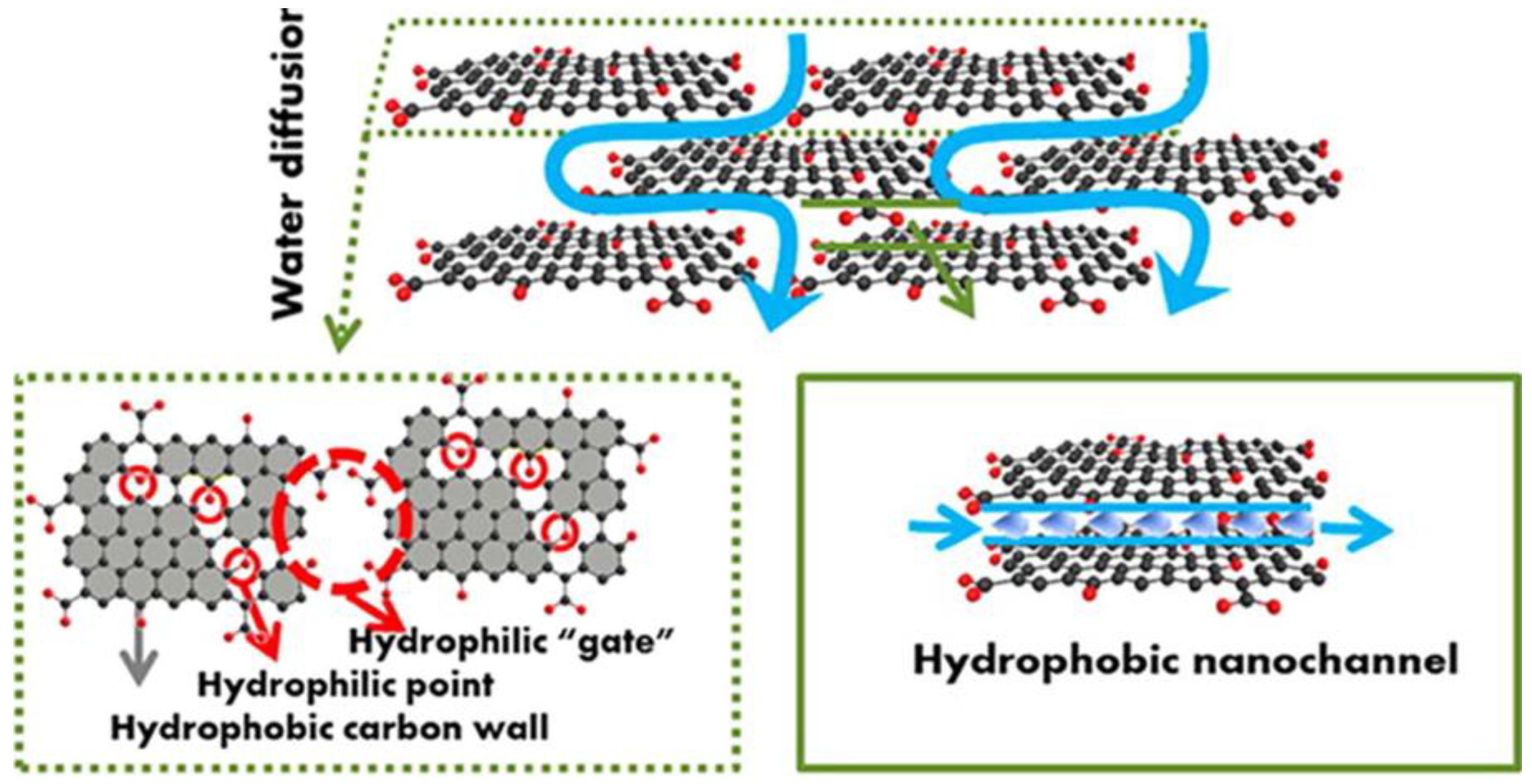
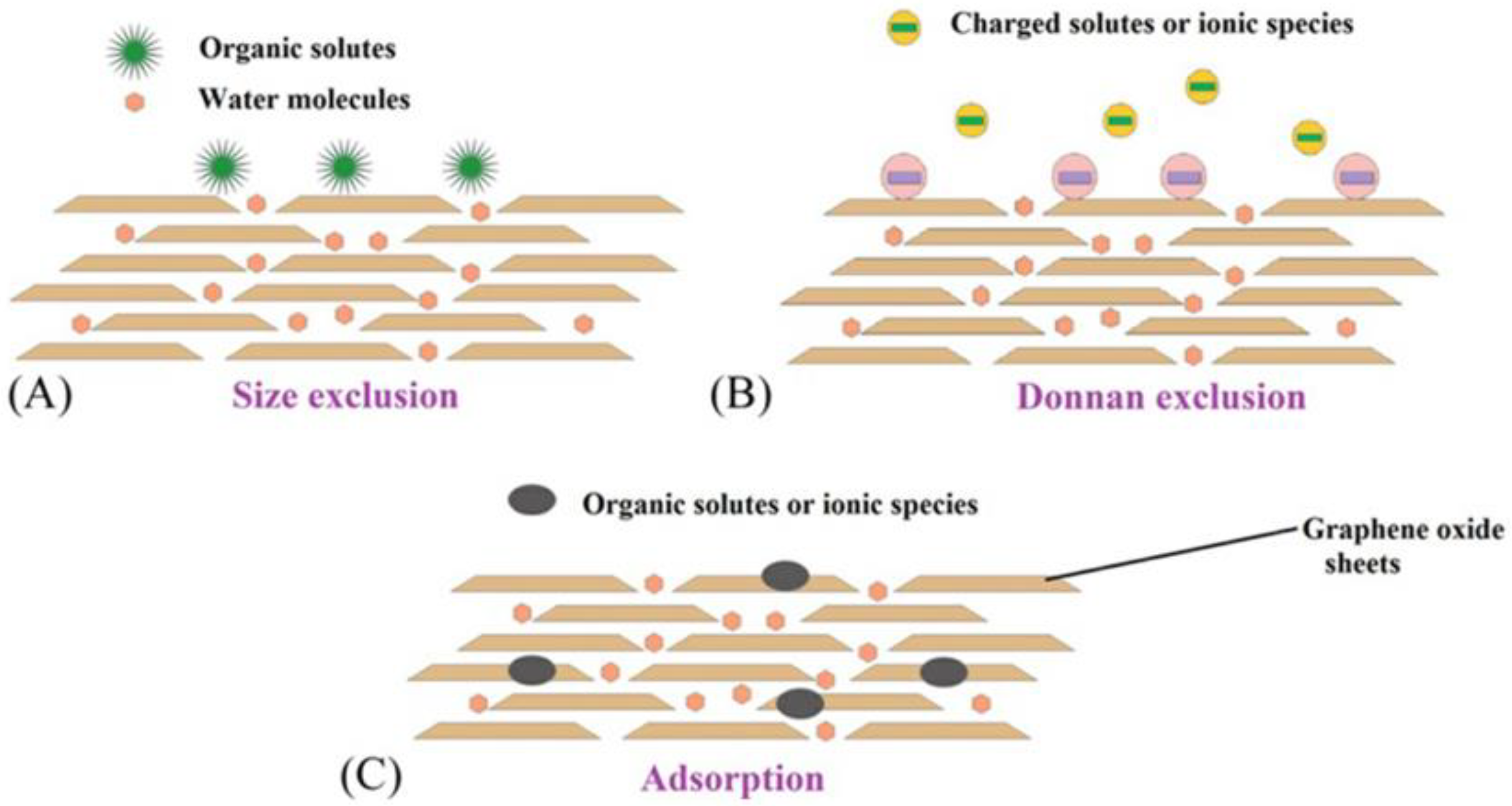




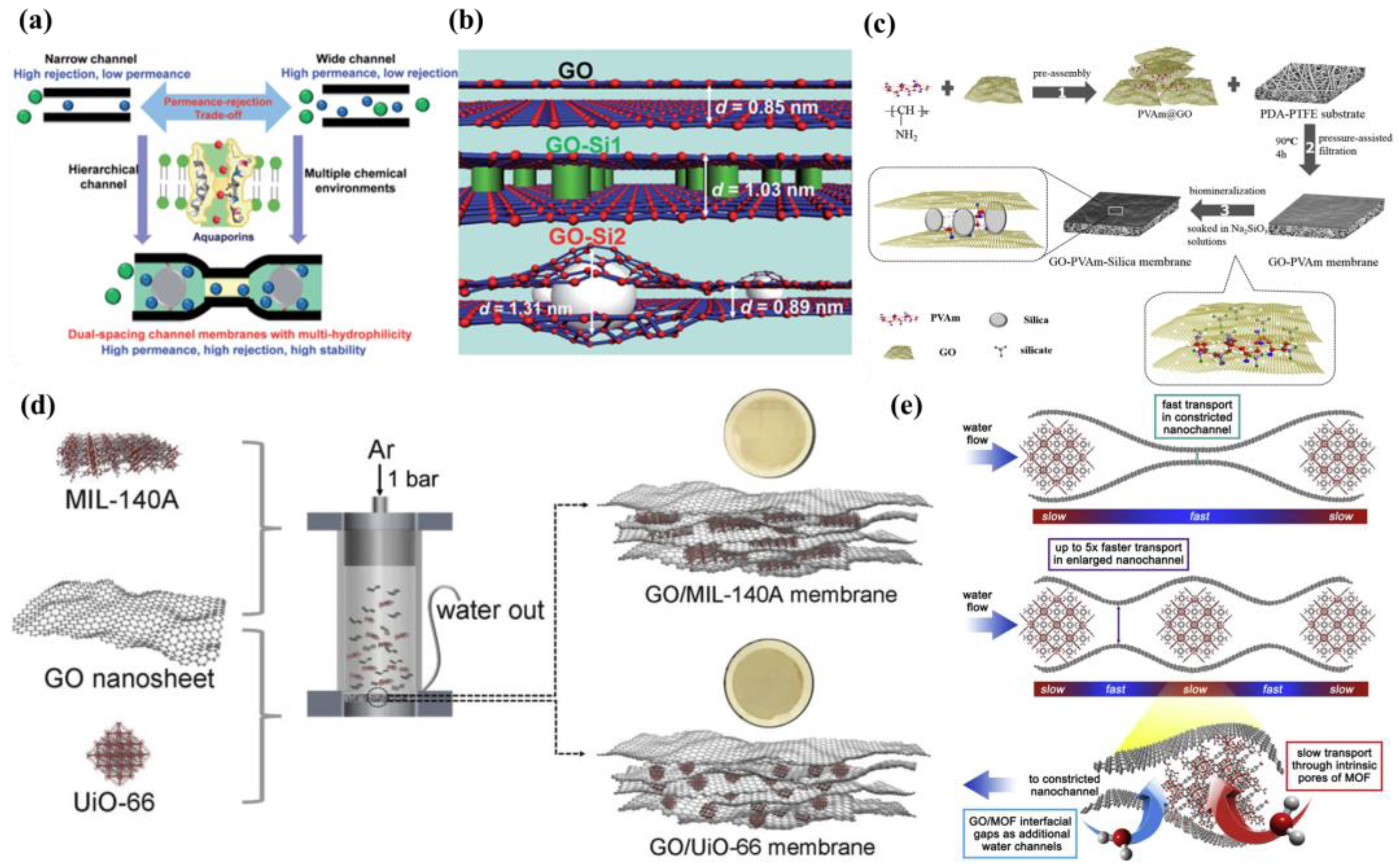
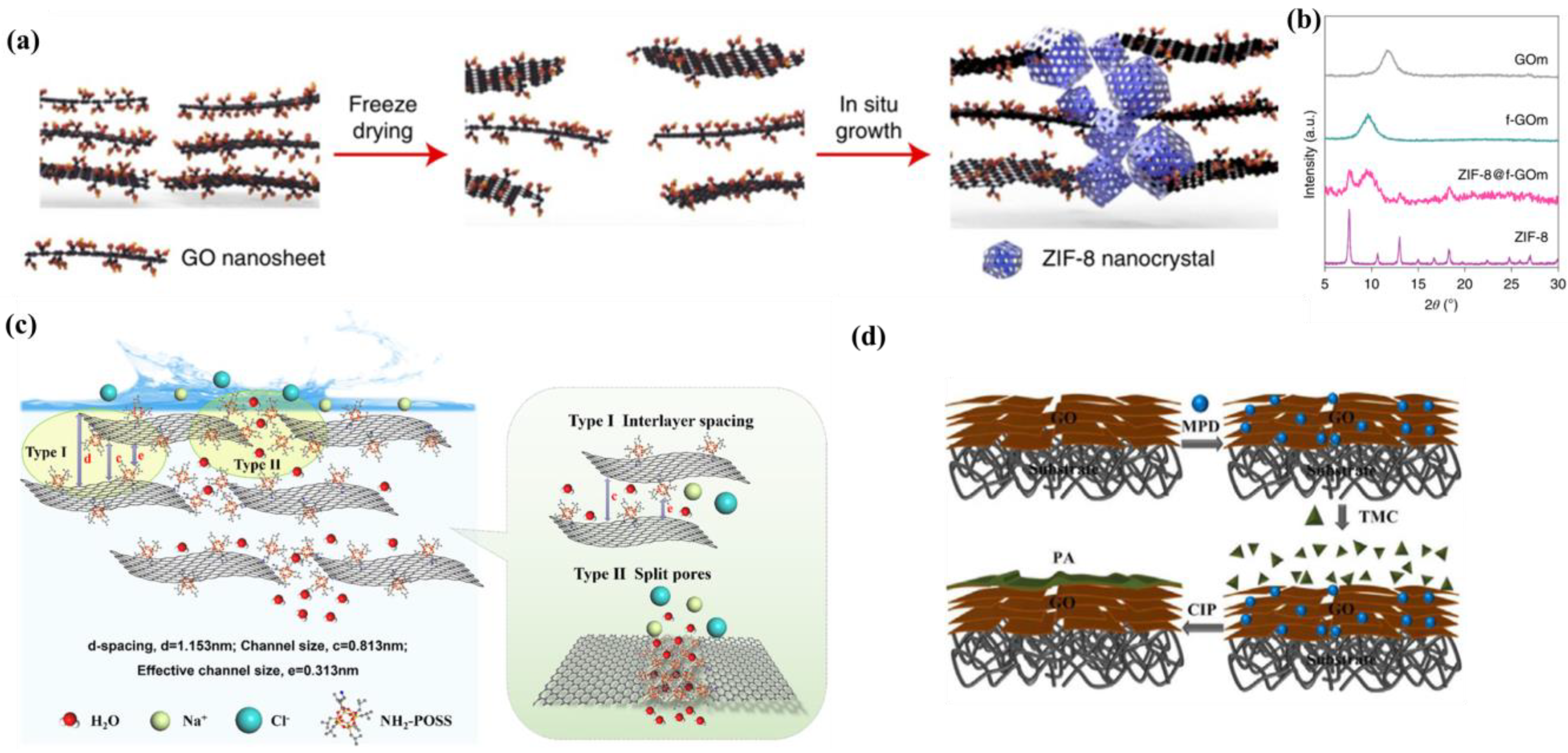
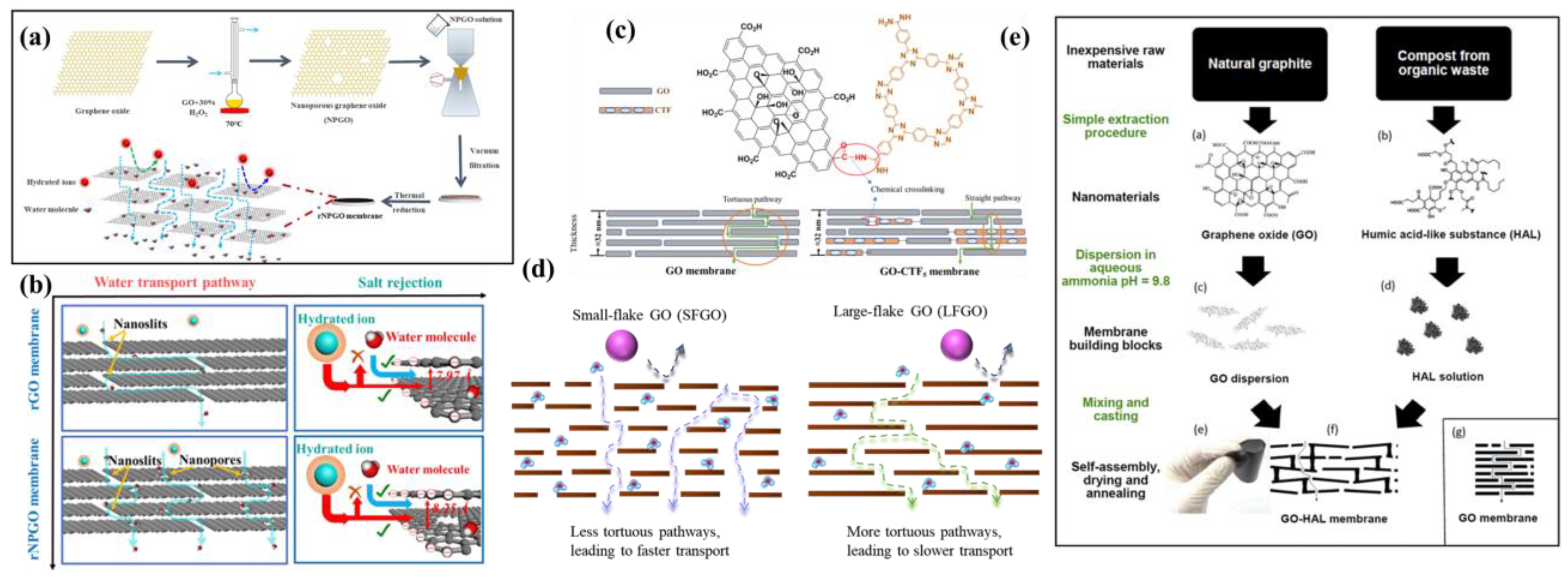
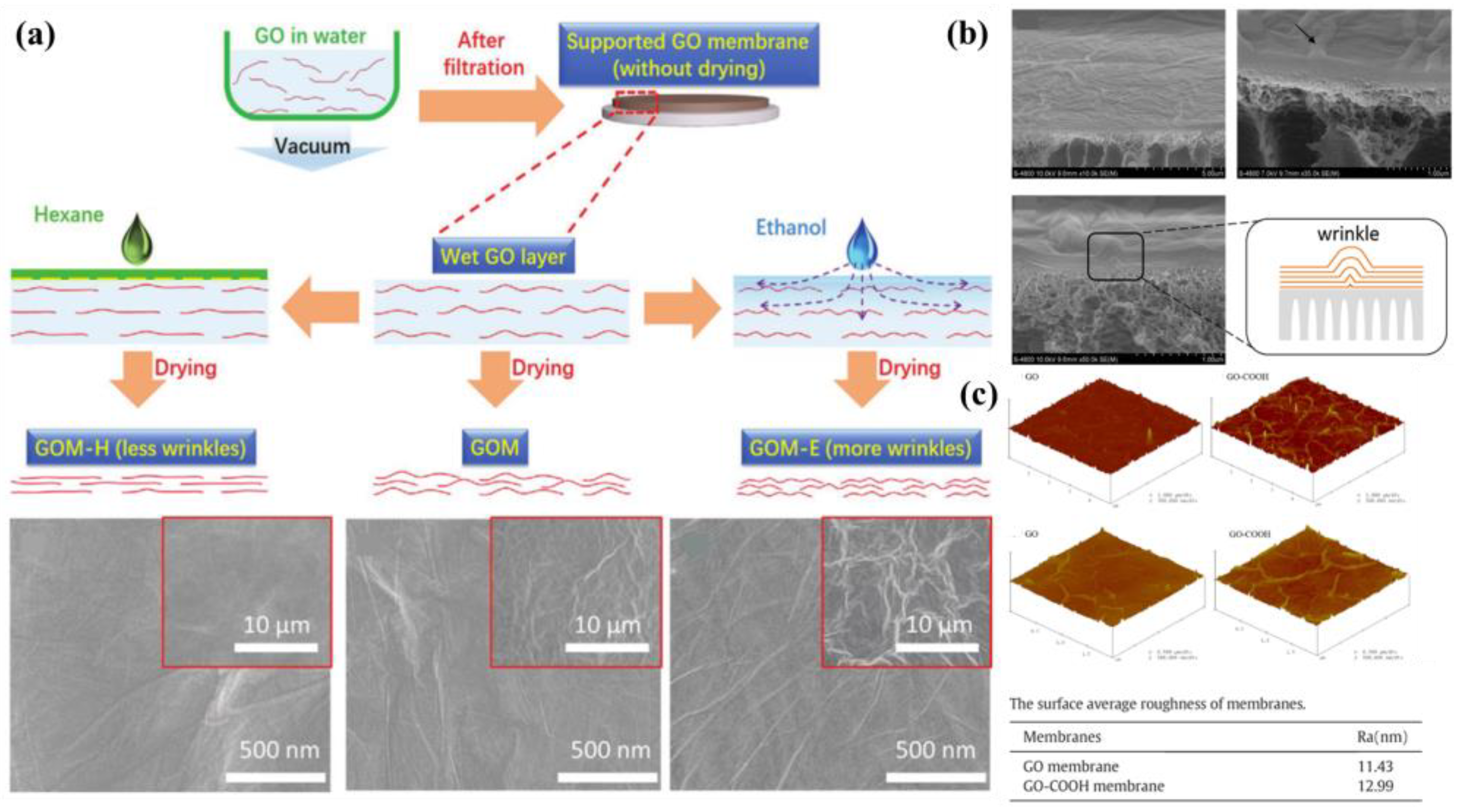
| Abbreviation of GO Membrane | Membrane Classification | Applied Pressure | Feed | Operating Temperature | Flux (LMH/Bar) | Rejection % | Reference |
|---|---|---|---|---|---|---|---|
| HRGO | NF | 0.4 MPa | 1 g/L Na2SO4 | RT | ~1.8 | ~90 | [57] |
| MRGO | NF | 0.4 MPa | 1 g/L Na2SO4 | RT | ~3 | ~95 | [57] |
| rNPGO | NF | 0.6 MPa | 20 Mm Na2SO4 | RT | ~39.93 | ~90 | [100] |
| BPPO/EDA/GO | NF | 0.1 MPa | 1 g/L Na2SO4 | RT | 4.1 | 56.2 | [107] |
| PEI/GO/PEI | NF | 0.5 MPa | 1 g/L Mg2SO4 | 30 °C | 4.2 | 93.9 | [38] |
| g-C3N4 | NF | 0.4 MPa | 1 g/L Na2SO4 | RT | 152 | 98.9 | [13] |
| PIP-GO | NF | 0.27 MPa | 0.5 g/L Mg2SO4 | RT | 242 | 90 | [108] |
| GO/phenolic | NF | 0.1 MPa | 0.5 g/L NaCl | RT | 165.6 | 97 | [109] |
| K-rGO | NF | 0.6 MPa | 1 g/L NaCl | RT | ~1.1 | ~91 | [68] |
| PA-GO | RO | 1 MPa | 2 g/L NaCl | RT | 3 | 99.7 | [99] |
| Abbreviation of GO Membrane | Membrane Classification | Feed | Operating Temperature | Flux (kg·m−2·h−1) | Rejection% | Reference |
|---|---|---|---|---|---|---|
| GO/PAN | PV | 2 wt% NaCl | 90 °C | 65.1 | 99.8 | [2] |
| Alg-GO-1 | PV | 3 wt% NaCl | 40 °C | 3.46 | 99.95 | [16] |
| A4-GO | PV | 3.5 wt% NaCl | 75 °C | 19.7 | 99.99 | [73] |
| GOF | PV | 3.5 wt% NaCl | 90 °C | 11.4 | 99.9 | [75] |
| POSS@GO | PV | 3.5 wt% NaCl | 80 °C | 112.7 | 99.98 | [15] |
| CDA-GOCM | PV | 3.5 wt% NaCl | 90 °C | 20.1 | 99.9 | [76] |
| CS/GO MMMs | PV | 5 wt% NaCl | 81 °C | 30 | 99.99 | [110] |
| GO-PVA | PV | 10 wt% NaCl | 90 °C | 98.0 | 99.99 | [84] |
| c-GO-PEI 70k | PV | 10 wt% NaCl | 90 °C | 86.0 | 99.9 | [19] |
| GO-PVAm-Silica | PV | 10 wt% NaCl | 70 °C | 80.2 ± 0.8 | 99.99 | [90] |
Disclaimer/Publisher’s Note: The statements, opinions and data contained in all publications are solely those of the individual author(s) and contributor(s) and not of MDPI and/or the editor(s). MDPI and/or the editor(s) disclaim responsibility for any injury to people or property resulting from any ideas, methods, instructions or products referred to in the content. |
© 2023 by the authors. Licensee MDPI, Basel, Switzerland. This article is an open access article distributed under the terms and conditions of the Creative Commons Attribution (CC BY) license (https://creativecommons.org/licenses/by/4.0/).
Share and Cite
Ge, R.; Huo, T.; Gao, Z.; Li, J.; Zhan, X. GO-Based Membranes for Desalination. Membranes 2023, 13, 220. https://doi.org/10.3390/membranes13020220
Ge R, Huo T, Gao Z, Li J, Zhan X. GO-Based Membranes for Desalination. Membranes. 2023; 13(2):220. https://doi.org/10.3390/membranes13020220
Chicago/Turabian StyleGe, Rui, Teng Huo, Zhongyong Gao, Jiding Li, and Xia Zhan. 2023. "GO-Based Membranes for Desalination" Membranes 13, no. 2: 220. https://doi.org/10.3390/membranes13020220
APA StyleGe, R., Huo, T., Gao, Z., Li, J., & Zhan, X. (2023). GO-Based Membranes for Desalination. Membranes, 13(2), 220. https://doi.org/10.3390/membranes13020220






